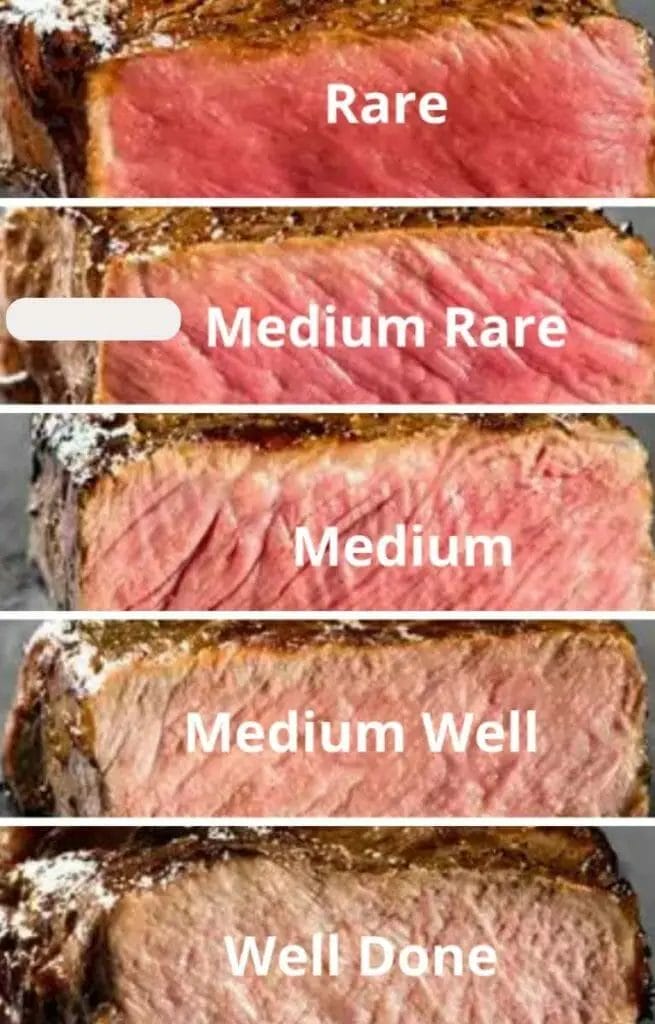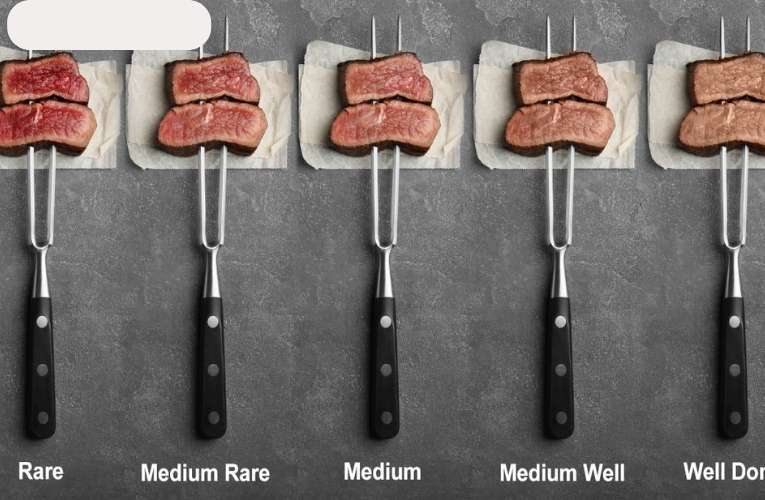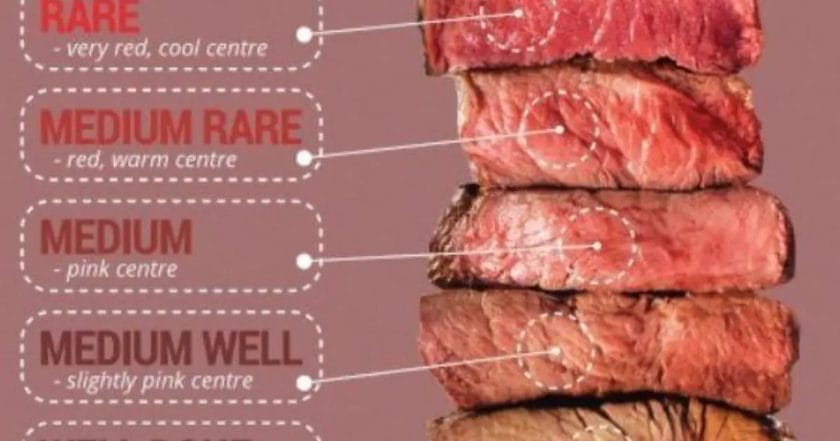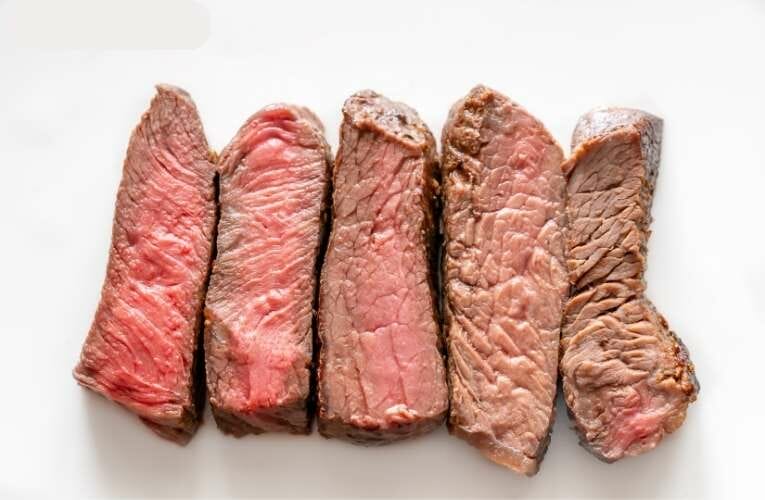If you’re a steak lover, choosing the perfect way to have your steak cooked is essential for an exceptional dining experience. From rare to well-done, every degree of doneness offers a unique flavor and texture.
Whether you prefer a juicy and pink center or a thoroughly cooked piece of meat, understanding the different options allows you to savor your steak just the way you like it. So, let’s dive in and explore the various degrees of doneness and find your perfect steak-cooking preference.

Understanding Steak Doneness Levels: A Guide to Perfectly Cooked Steaks
When it comes to cooking steaks, achieving the perfect level of doneness is key to maximizing flavor and tenderness. Whether you prefer a rare, medium-rare, medium, or well-done steak, understanding the different doneness levels and how to achieve them can elevate your steak-cooking game.
In this guide, we will walk you through the various steak doneness levels and provide tips on how to cook your steak to perfection.
Rare
Rare steaks are cooked quickly at high heat to seal in the juices while leaving the center cool and red. The internal temperature for a rare steak should be around 125°F (52°C).
Cooking times for rare steaks can vary depending on the thickness of the cut and the heat of your cooking surface. For a 1-inch thick steak, aim for a cooking time of approximately 4-5 minutes per side.
To achieve a rare steak, start by preheating your grill or pan on high heat. Season your steak with salt and pepper, and then place it on the hot cooking surface. Cook the steak for the recommended time per side, flipping it only once.
Use a meat thermometer to check the internal temperature, and remove the steak from the heat when it reaches around 125°F (52°C). Let the steak rest for a few minutes before serving to allow the juices to redistribute.
Medium-Rare
Medium-rare steaks are cooked slightly longer than rare steaks, with a slightly warmer center and a pink and juicy interior. The internal temperature for a medium-rare steak should be around 135°F (57°C).
Cooking times for medium-rare steaks are similar to rare steaks, but you may need to add an extra minute or two per side.
To achieve a medium-rare steak, follow the same cooking process as you would for a rare steak, but cook it for a slightly longer time.
Use a meat thermometer to check the internal temperature, and remove the steak from the heat when it reaches around 135°F (57°C). Let the steak rest before slicing and serving.
Medium
Medium steaks have a warm pink center and are slightly firmer than medium-rare steaks. The internal temperature for a medium steak should be around 145°F (63°C).
Cooking times for medium steaks may vary depending on the thickness of the cut, but aim for approximately 6-7 minutes per side for a 1-inch thick steak.
To achieve a medium steak, cook it slightly longer than you would for medium-rare. Use a meat thermometer to check the internal temperature, and remove the steak from the heat when it reaches around 145°F (63°C). Allow the steak to rest for a few minutes to let the juices settle before serving.
Well-Done
Well-done steaks are cooked through and have no pinkness in the center. The internal temperature for a well-done steak should be around 160°F (71°C).
Cooking times for well-done steaks will be longer than for the previous doneness levels. For a 1-inch thick steak, cook it for approximately 10-12 minutes per side.
To achieve a well-done steak, cook it for an extended period of time compared to the other doneness levels. Use a meat thermometer to check the internal temperature, and remove the steak from the heat when it reaches around 160°F (71°C). Let the steak rest before slicing and serving.
Different Cuts of Steak: Exploring Varieties for the Ultimate Dining Experience
When it comes to indulging in a delicious steak, the cut of meat you choose can make all the difference. Each cut has its own unique flavor profile, texture, and tenderness that can elevate your dining experience to new heights.
In this section, we will be exploring the different cuts of steak, so you can make an informed decision the next time you visit a steakhouse or cook at home.
1. Ribeye
Known for its rich marbling and intense flavor, the ribeye is a favorite among steak enthusiasts. This cut comes from the rib section of the cow and is highly prized for its tenderness. It has a buttery texture and is incredibly juicy, making it perfect for those who enjoy a melt-in-your-mouth experience.
2. Filet Mignon
Often considered the king of steaks, filet mignon is renowned for its unparalleled tenderness. Cut from the tenderloin, this steak is lean and offers a delicate flavor.
It may not have the same level of marbling as other cuts, but its tenderness more than makes up for it. Filet mignon is often served in high-end restaurants and is perfect for those who prefer a leaner and more refined steak.
3. New York Strip
The New York strip, also known as the striploin, is a classic choice for steak lovers. This cut comes from the short loin and offers a balance of tenderness and flavor.
It has a slightly firmer texture compared to the ribeye but is still incredibly tender. The New York strip is known for its robust beefy flavor and is a favorite among those who enjoy a hearty steak with a good bite.
4. T-Bone
The T-bone steak is named after the T-shaped bone that runs through it. This cut is a combination of the tenderloin and the New York strip, offering the best of both worlds.
The tenderloin side of the T-bone provides that melt-in-your-mouth tenderness, while the strip side offers a more robust flavor. It’s like having two steaks in one, making it a popular choice for those who can’t decide on a single cut.
5. Porterhouse
Similar to the T-bone, the porterhouse steak is a generous cut that combines the tenderloin and the New York strip. The main difference is that the porterhouse is larger, with a bigger portion of the tenderloin.
This means you get more of that exquisite tenderness in every bite. The porterhouse is perfect for sharing or for those with a hearty appetite.
6. Sirloin
Sirloin steak is a versatile cut that offers a balance of flavor and tenderness. It comes from the rear back portion of the cow and is known for its rich, beefy taste.
While it may not have as much marbling as some of the other cuts, it is still incredibly flavorful and can be cooked to perfection with the right techniques. Sirloin steak is a popular choice for grilling and is often used in dishes like stir-fries and fajitas.
7. Flank Steak
Flank steak is a lean and flavorful cut that comes from the abdominal muscles of the cow. It has a distinct grain and is known for its intense beefy flavor.
While it may not be as tender as some of the other cuts, it is incredibly versatile and can be marinated to enhance its tenderness and flavor. Flank steak is commonly used in dishes like fajitas, stir-fries, and as a filling for tacos.
8. Skirt Steak
Skirt steak is a thin and flavorful cut that comes from the diaphragm muscles of the cow. It has a loose texture and is known for its intense beefy flavor.
Skirt steak is perfect for grilling or searing and is often used in dishes like fajitas and carne asada. While it may require a bit of extra care to ensure tenderness, the flavor payoff is well worth it.

Grilling vs. Pan-searing: Pros and Cons of Different Cooking Methods for Steaks
Cooking a steak to perfection is an art that many food enthusiasts strive to master. One of the fundamental choices that home cooks face when preparing a steak is whether to grill it or pan-sear it.
Both methods have their advantages and disadvantages, and understanding them can help you decide which approach is best for your culinary preferences and circumstances.
Grilling
Grilling a steak is a timeless cooking method that brings out the natural flavors of the meat while imparting a smoky and charred finish. Here are some pros and cons of grilling:
Pros:
- Smoky Flavor: Grilling infuses steaks with a distinct smoky flavor that many people find irresistible.
- Charred Crust: The direct heat of the grill creates a beautiful charred crust on the outside of the steak, adding texture and complexity.
- Cooking for a Crowd: Grilling is an excellent choice when you need to cook for a large group of people, as it allows you to prepare multiple steaks simultaneously.
- Outdoor Experience: Grilling provides an opportunity to enjoy the outdoors and create a festive atmosphere.
Cons:
- Weather Limitations: Grilling requires suitable weather conditions, making it less feasible during cold or rainy seasons.
- Less Control: It can be challenging to control the heat and temperature while grilling, potentially leading to overcooking or undercooking.
Pan-searing
Pan-searing is a stovetop cooking method that involves searing the steak in a hot skillet and finishing it in the oven. Here are some pros and cons of pan-searing:
Pros:
- Even Cooking: Pan-searing allows for precise control over the cooking process, resulting in an even and consistent cook throughout the steak.
- Crispy Exterior: The direct contact with a hot skillet creates a crispy exterior, which contrasts beautifully with the tender interior of the steak.
- Indoor Cooking: Pan-searing can be done indoors, making it a convenient option regardless of the weather conditions.
- Controlled Smoke: While pan-searing does not offer the same smoky flavor as grilling, you can add additional aromatics to the pan to infuse the steak with a unique flavor.
Cons:
- No Grilled Flavor: Pan-searing does not provide the distinct smoky flavor associated with grilling, which some steak enthusiasts prefer.
- Smoke and Odor: Cooking a steak in a hot skillet can generate smoke and lingering odors in your kitchen, which may not be desirable for some individuals.
- Less Capacity: Pan-searing is more suitable for cooking one or two steaks at a time, making it less efficient for larger gatherings.

Insider Tips for Marinating Steaks: Enhancing Flavor and Tenderness
Marinating steaks is a great way to add flavor and tenderness to your favorite cuts of meat. Whether you prefer a juicy ribeye or a tender filet mignon, a well-marinated steak can take your dining experience to the next level.
In this section, we will explore some insider tips and techniques for marinating steaks, ensuring that your meat is bursting with flavor and melt-in-your-mouth tender.
1. Choose the Right Marinade
The first step to a successful steak marinade is choosing the right flavor profile. Think about the taste you want to achieve and select a marinade that complements it.
You can opt for classic combinations like garlic and herb, soy and ginger, or even a tangy barbecue sauce. Experiment with different marinades to find your favorite.
2. Tenderize the Meat
Before marinating your steaks, it’s crucial to tenderize them. This process helps the marinade penetrate the meat, resulting in a more flavorful and tender steak.
You can tenderize the meat by using a meat mallet or a tenderizing marinade. Simply use the mallet to gently pound the steak, or let it soak in a tenderizing marinade according to the instructions on the package.
3. Marinating Time
The marinating time can vary depending on the thickness and cut of the steak. Generally, it is recommended to marinate steaks for at least 30 minutes to 24 hours.
Thinner cuts like flank or skirt steak can benefit from shorter marinating times, while thicker cuts like ribeye or sirloin may require longer marinating periods for optimal flavor infusion.
4. Proper Marinating Technique
When marinating steaks, it’s essential to ensure that the meat is evenly coated with the marinade. Place the steaks in a shallow dish or a resealable plastic bag and pour the marinade over them.
Massage the marinade into the meat, making sure every surface is covered. For even better results, you can flip the steaks occasionally during the marinating process.
5. Don’t Overdo it
While marinating adds incredible flavor, it’s crucial not to over-marinate the steaks. Over-marinating can lead to a mushy texture and overpowering flavors.
Follow the recommended marinating time and avoid marinating the steaks for too long. If you want a stronger flavor, you can reserve a portion of the marinade to brush onto the steaks while grilling.
6. Pat Dry Before Cooking
Prior to grilling or cooking, make sure to pat dry the marinated steaks. Excess moisture on the surface can prevent proper searing and browning.
Use a paper towel or a clean kitchen towel to gently remove any moisture from the steaks. This will help create a delicious crust and prevent steaming during the cooking process.
7. Allow the Steaks to Rest
After cooking the marinated steaks, it’s important to let them rest before slicing. Resting allows the juices to redistribute throughout the meat, resulting in a more flavorful and tender steak. For best results, tent the steaks with aluminum foil and let them rest for about 5-10 minutes before serving.
8. Pair with Delicious Sides
A perfectly marinated steak deserves equally delicious sides to complete the meal. Consider serving your steaks with classic accompaniments like roasted potatoes, grilled vegetables, or a fresh salad. The side dishes can enhance the overall dining experience and complement the flavors of your marinated steak.
By following these insider tips for marinating steaks, you can elevate your grilling game and enjoy restaurant-quality results at home. Experiment with different marinades, cooking techniques, and side dishes to create a culinary masterpiece that will impress your family and friends. Happy grilling!

Serving Suggestions: Mouthwatering Side Dishes to Complement Your Steak Dish
When it comes to enjoying a delicious steak dish, the right side dishes can take your meal to the next level. While a perfectly cooked steak is undoubtedly the star of the show, the right accompaniments can enhance its flavors and provide a well-rounded dining experience.
Whether you prefer classic pairings or want to venture into something new, here are some mouthwatering side dishes that will complement your steak dish like a match made in culinary heaven.
Baked Potatoes with Herb Butter
There’s nothing quite like a baked potato to complement a juicy steak. Soft on the inside and crispy on the outside, a perfectly baked potato is a classic side dish that never fails to impress.
Top it off with a generous dollop of herb butter, made with a blend of fresh herbs like parsley, thyme, and rosemary, for an added burst of flavor.
Grilled Asparagus
If you’re looking for a healthy and flavorful side dish, grilled asparagus is an excellent choice. Lightly charred on the grill, these tender spears bring a delightful smoky flavor that pairs beautifully with steak. Drizzle some lemon juice and sprinkle a touch of sea salt for a refreshing and tangy twist.
Creamed Spinach
For a luxurious and creamy side dish, creamed spinach is a winner. The velvety texture of the spinach combined with a rich and decadent sauce creates the perfect balance of flavors. The creamy goodness of this dish beautifully complements the bold flavors of a well-seasoned steak.
Mushroom Risotto
If you’re a fan of risotto, you’ll love the earthy and savory goodness of mushroom risotto alongside your steak. The combination of tender Arborio rice and sautéed mushrooms creates a luscious and indulgent dish that pairs perfectly with a perfectly cooked steak.
Roasted Brussel Sprouts with Bacon
For a side dish that adds a delicious crunch to your steak dinner, look no further than roasted Brussels sprouts with bacon.
The natural sweetness of the Brussels sprouts intensifies as they roast, and the addition of crispy bacon elevates the dish to a whole new level. This irresistible combination will have you coming back for seconds.
Garlic Parmesan French Fries
If you’re craving a classic comfort food side dish, garlic Parmesan French fries are a must-try. Crispy on the outside and fluffy on the inside, these fries are tossed in a fragrant garlic and Parmesan cheese mixture that adds a burst of flavor. They are the perfect accompaniment to a juicy steak.
Caprese Salad
For a lighter and refreshing side dish, a classic Caprese salad is an excellent choice. Made with ripe tomatoes, fresh mozzarella cheese, and fragrant basil leaves, this salad brings together the perfect balance of flavors. Drizzle with balsamic glaze for an extra touch of sweetness.
Grilled Corn on the Cob
When it’s grilling season, there’s nothing quite like sinking your teeth into a juicy ear of grilled corn on the cob.
The smoky flavors of the grill enhance the natural sweetness of the corn, making it an ideal side dish for steak. Brush it with some melted butter and sprinkle with your favorite seasonings for an extra kick.
Roasted Garlic Mashed Potatoes
Mashed potatoes are a timeless classic that can never go wrong when paired with steak. Take it up a notch by infusing roasted garlic into your mashed potatoes for a burst of flavor.
The creamy and velvety texture of the mashed potatoes combined with the earthy, caramelized notes of roasted garlic will make this side dish a hit.
Grilled Zucchini and Squash
For a light and summery side dish, grilled zucchini and squash are a fantastic choice. The smoky char from the grill adds depth to the natural sweetness of the vegetables, creating a delicious combination. Toss them with some olive oil, salt, and pepper before grilling for a simple yet satisfying dish.

FAQs
1. How do you like your steak?
Please let us know your preferred cooking level for your steak, such as rare, medium rare, medium, medium well, or well done.
2. Can I make changes to my order?
Yes, you can make changes to your order. Please contact our customer service within a reasonable time frame to make any modifications.
3. What payment methods do you accept?
We accept various payment methods, including credit cards (Visa, Mastercard, American Express), debit cards, and online payment platforms like PayPal.
Conclusion
In conclusion, choosing how you would like your steak cooked is a matter of personal preference. Whether it’s rare, medium rare, medium, or well-done, the key is to make sure the steak is cooked to your liking.
When it comes to steak, there is no right or wrong answer. It’s all about getting that perfect balance of tenderness, juiciness, and flavor. Remember to communicate your preference to the chef or server to ensure they prepare your steak exactly how you want it.
So, next time you’re at a steakhouse or grilling at home, don’t be afraid to ask for your steak cooked just the way you like it. Enjoy the deliciousness of a perfectly cooked steak tailored to your taste buds!

